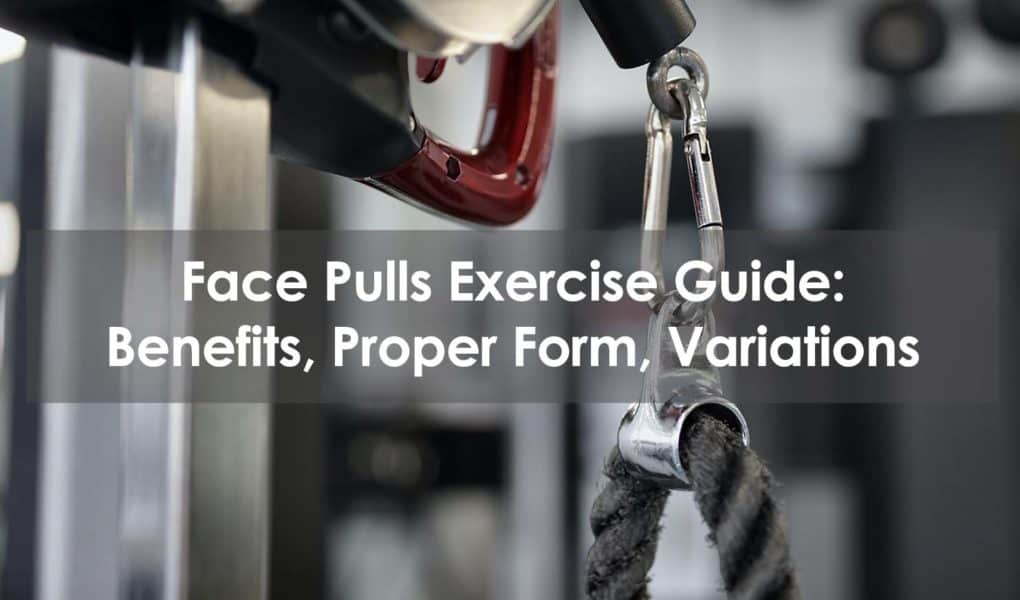When you hear the term ‘face pulls’ as an exercise, it’s hard to imagine what that would look like. Most people don’t think to add it to their workout regimen, and it shows. Too often, we see the general gym-goer and even some of the more fitness-savvy skip over this simple and reasonably essential exercise.
Benefits of Face Pulls
Although it is vital within the experienced fitness and weightlifting community, it is overlooked and underrated. Simply put, face pulls are a multifunctional lift that incorporates your rear deltoids and mid and upper back muscles. It’s an excellent workout for building and developing your back and maintaining shoulder health and helps with improved posture.
As a result of constant pressing, pushing, a widespread problem most lifters run into is the internal rotation of the shoulder joint, i.e., “rounded shoulders.” Face pulls are excellent for balancing the muscles that support the shoulders and upper body, so you don’t develop a spinal injury or shoulder dysfunction.
Face Pulls Proper Form
For proper face pull form, you should feel it in these four muscles: posterior deltoid, middle and lower traps, infraspinatus, and teres major.
The key is control.
To start, you’ll want to use a pulley machine typically with a double rope attachment; if you don’t have access to one, you can use a resistance band, or free weights as an option.
Set the height to match your upper chest, and use an underhand grip in a neutral grip. This grip position will give you a wider external rotation of motion which is better for the external rotators in your shoulders.
As you pull, make sure to keep your head stationary, chest up, and shoulders back while keeping your elbows parallel to the ground. Spread out both ends of the rope apart while pulling toward your face and squeezing your shoulder blades together. Hold that position for 1 to 2 seconds before releasing back to the starting position.
You want to use a modest weight and perform 3-4 sets of 8-12 smooth and controlled reps for the best results.
Face pulls can be a great addition to your shoulder and back training routine and can also be done at home.
Face Pulls Alternatives
Every fitness expert, athlete, and weight lifter who uses face pulls as a part of their routine understands the benefits and how it works. For the not-so-knowledgeable average gym-goer, we’ll briefly explain the science behind it. When performing, you’re doing what is known as “transverse abduction,” which is lateral movement or your rear delts.
This movement is quite complex and to do it correctly takes a lot of practice and patience. So in case you haven’t built enough courage to try, there are plenty of face pulls alternatives that use similar movement to help you practice proper technique while targeting the same group of muscles. These lifts and pulls are simple to do and don’t require a cable pulley machine or heavy gym equipment, you can easily do it with resistance bands.
They can also come in handy when you’re stuck at home, or you’re at the gym waiting on someone to get off of the cable machine.
Face Pulls Variations
Let’s say you’ve gotten to a point where you’ve pretty much-mastered face pulls, and it’s not working the same as it did when you started. Luckily there are equally challenging variations that target your muscles in an unorthodox way.
1. Overhand Grip Face Pulls
For this variation, you use an overhanded grip while performing the same motion. Although it limits the range of external rotation, it’s great for lifting larger/heavier weights if you want to build broader shoulders.
2. Seated Face Pulls
Seated face pulls is an excellent option for learning and perfecting form. Using a lightweight, you learn to focus on centration during rotation while controlling the motion. Another helpful tip is to adjust the height above your head to utilize horizontal movement and incorporate your shoulders more.
3. Face Pulls with Arm Raise
This variation adds an extra movement to the exercise and includes your lower traps and the other targeted muscles. When you’ve pulled the rope attachment to your face, you will raise your arms, keeping the same tension in your back, and slowly bring them back to the second position. It’s an excellent modification for building strength in the scapula and shoulder girdle but it does put a bit more strain on the rotator cuff.
4. Dumbbell Face Pulls
If you don’t have access to a cable machine or any basic resistance band, dumbbell exercises are great alternatives for doing face pulls. For the starting position, lie chest down on an incline bench with your dumbbells in hand lowered to the ground. The weights should be positioned horizontally, and you’ll slowly lift, keeping your elbows pointed outward. Lift to your face and squeeze your shoulders together for 1-2 seconds before slowly releasing back to the starting position.
Face Pulls Common Mistakes
Face pulls, specifically, happen to be an activity that is very easy to do incorrectly. For your safety and to ensure you get the most effective workout, we’ll go over some common mistakes people make.
1. Poor Form
It should go without saying that poor form in any athletic or fitness activity is a waste of time and energy. As we’ve mentioned earlier, face pulls are hard to do correctly, and there are lots of factors you have to be mindful of; otherwise, you won’t get anything out of it. A few examples would be: if your elbows aren’t parallel to the ground, your head is too far forward, or you’re focusing tension in your arms rather than your back and bad shoulder position.
2. Too Much Weight
A huge misconception in weightlifting is if you want a better workout, you should add extra weight. In general, adding more weight than necessary for any push, pull, or drill will not benefit you. Specifically, with face pulls, too much weight will cause you to compromise proper form, and you’re more likely to injure yourself than anything. Always choose a weight that is light enough to use good technique but heavy enough to challenge yourself.
3. Incorrect Height
When choosing height for a face pulls, the cable or rope must be around the same level as your upper chest and clavicle. Any slight deviation could affect which muscles are targeted or change the difficulty of the motion. You should be able to move your arms and shoulders in the correct position comfortably without any shoulder pain.
4. Improper Stance
Having a lousy athletic stance and poor posture might seem like a minor issue, but it’s more common than you might think. Having a proper footing is helpful because it’s an indicator of how much weight is too much. Most people aren’t sure whether or not they should be in a staggered position or if they should keep their feet square. Most experts will tell you to have your feet square in a slightly squatted position.
5. Relying on Momentum
A very big common mistake is relying on your momentum to lift the weight. Having to rely on quickly doing a rep to complete a workout is fruitless, and you won’t activate a single muscle you’re attempting to target. You also put yourself at risk of injury from training. Always – and we do mean always – control your movement.
Final Thoughts
Although it isn’t the most popular exercise, you can see how important face pulls are and why you should always include them in your regime. It’s vital for healthy shoulders and upper back strength; it promotes correct posture and prevents back problems and muscle imbalance. So why wouldn’t you want to have this a part of your training routine?
Frequently Asked Questions
Can I Do Face Pulls Every Day?
With face pulls, if you adjust the weight and focus on the targeted areas, you can do this exercise every day. However, you should be cautious about overworking your muscles as it can lead to injury; always make room for rest.
Do Face Pulls Work Shoulders?
Face pulls target the rear deltoid and mid to lower traps. Because most of the motion is made with the shoulders, it helps strengthen your rotator cuffs located in your shoulders – in short, face pulls help build strong shoulders.







